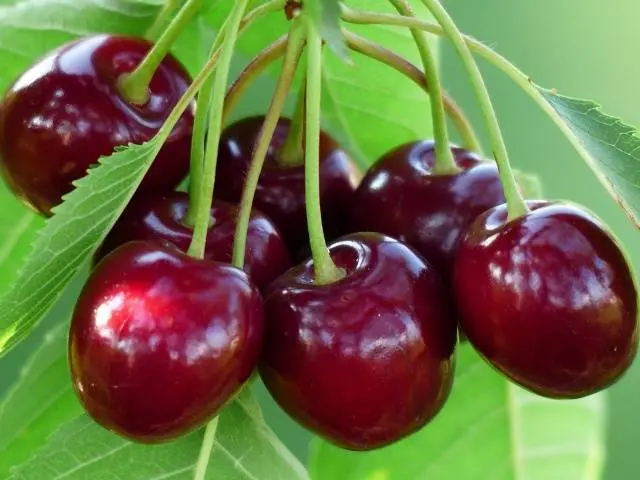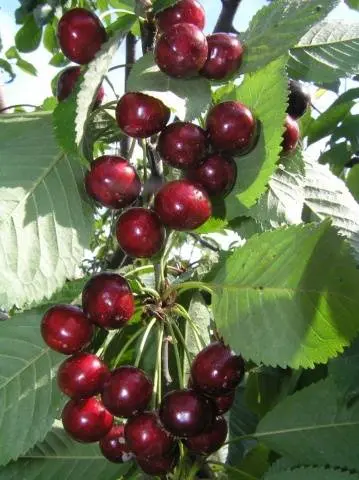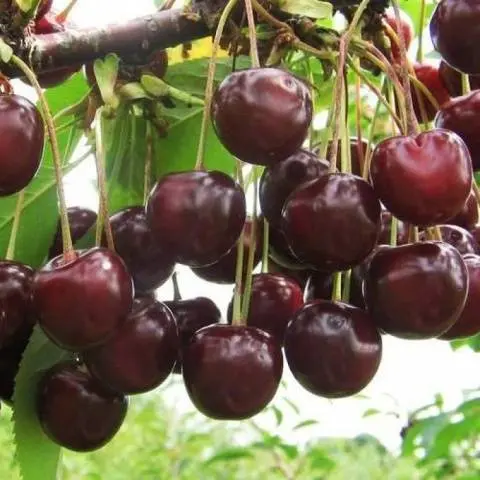Contents
Cherry Veda is a promising variety of domestic selection. It is valued for the universal purpose of fruits and high frost resistance.
History of breeding
Variety Veda obtained in the Federal Scientific Center “VIK im. V.R. Williams”. Its authors were breeders M.V. Kanshina, A.A. Astakhov, L.I. Zuev. In 2007, the hybrid was accepted for state variety testing. In 2009, information about the variety is present in the State Register.
Description of the culture
Variety Veda is characterized by late ripening and universal use of fruits.
Description of the Veda cherry variety:
- medium sized fast growing tree;
- spreading, dense, rounded crown;
- skeletal branches are located at right angles;
- straight shoots of gray-green color;
- large ovoid leaves;
- the leaf plate is green, smooth, with a pointed tip.
The tree produces large white flowers collected in triple inflorescences. The fruits are large, one-dimensional, weighing 5,1 g, heart-shaped. The color is dark red, the subcutaneous dots are barely noticeable. The skin is tender, the flesh is dark red, juicy. The juice is sweet, rich red.
Tasting properties are estimated at 4,6 points. The fruits contain 18% dry matter; 11,5% sugar; 0,7% acid. The stone is located freely and easily separated from the pulp.
The variety Veda is recommended for cultivation in the Central region of Our Country (Bryansk, Vladimir, Kaluga, Ivanovo, Moscow, Ryazan, Smolensk and Tula regions).
Photo of cherry Veda:

Features
Before planting, the characteristics of the Veda sweet cherry variety are evaluated: resistance to drought, frost, diseases and pests.
Drought resistance, winter resistance
Variety Veda does not tolerate prolonged drought, especially during flowering and fruit ripening. Watering is one of the essential steps in tree care.
The frost resistance of the Veda cherry is rated at a high level. The tree tolerates a decrease in temperature in winter to -30 ° C.
Pollination, flowering period and ripening period
The Veda variety is self-infertile and requires the planting of pollinators to produce a crop. The best pollinators for Veda sweet cherries: Leningradskaya black, Revna, Tyutchevka, Ipul, Bryanochka or other varieties that bloom late.
Flowering begins in May. The harvest is taken in late June – early July.
yield, fruiting
The average yield, subject to the rules for planting and caring for Veda cherries, is 77 c/ha. Up to 30 kg of fruits are harvested from one tree. The stalk is easily separated from the branch.
The fruits ripen at the same time. To avoid shattering, it is recommended to collect them immediately after ripening.
Scope of berries
Sweet cherries are consumed fresh, used to create fruit and berry desserts, and decorate confectionery. The fruits are used in home canning for making jams and compotes.
Disease and pest resistance
Variety Veda requires protection from diseases and pests. For spraying, protective preparations are purchased that are dissolved in water.
Advantages and disadvantages
The main advantages of growing Veda cherries:
- large fruits;
- good taste;
- high winter hardiness.
Disadvantages of the Veda variety:
- requires the planting of a pollinator;
- takes a long time to bear fruit.
Features of landing
Healthy seedlings of the Veda variety are chosen for planting. The terms of work are determined taking into account the climatic features of the region.

Recommended dates
In warm regions, the crop is planted in the fall, 3-4 weeks before the cold snap. In the middle lane, landing is carried out in the spring after the snow melts, but before the buds open.
Choosing the right place
Sweet cherry prefers lighted slopes on the south side of the site. The groundwater level is more than 2 m. They are not suitable for planting places in the lowlands, where moisture and cold air accumulate.
The culture develops well on loam or sandstone. It is not recommended to plant in soil with a high content of sand, clay or peat.
What crops can and cannot be planted next to cherries
Best of all, the culture grows next to cherries and other varieties of cherries. From apple, pear and other tall trees, the seedling is removed by 4-5 m.
It is not recommended to plant a tree next to hazel, raspberries, currants, tomatoes, peppers and potatoes.
Selection and preparation of planting material
One- or two-year-old seedlings of the Veda variety are suitable for planting. Pre-evaluate the root system and crown. The tree should not show signs of damage, rotting, dry patches.
The roots of the seedling are dipped in water for 2 hours, and the leaves are cut off. If the roots are dried, they are kept in water for 10 hours.
Landing algorithm
The procedure for planting the Veda cherry variety:
- On the site, they dig a hole measuring 1×1 m and a depth of 80 cm.
- The fertile soil layer is mixed with 200 g of superphosphate, 50 g of viburnum salt and 0,5 kg of ash.
- Part of the soil mixture is poured into the pit, within 2-3 weeks the soil will shrink.
- The remaining substrate is filled with a pit and a tree is planted.
- The roots of the seedling are covered with earth.
- The soil in the near-stem circle is watered abundantly.
Culture aftercare
Veda cherry care comes down to watering, fertilizing and pruning. The culture needs watering before flowering, in the middle of summer and in autumn in preparation for winter. For each tree, 2 buckets of water are consumed.

The subcortex of culture is carried out according to the scheme:
- in early spring, 15 g of urea, superphosphate and potassium salt are added to the soil;
- after harvesting, the trees are sprayed with a solution of superphosphate and potassium sulfate (10 g of each substance per 10 liters of water).
The tree is pruned annually to properly form the crown. Skeletal branches and conductors are shortened, and excess, dry and frozen shoots are completely eliminated. Pruning is carried out in early spring or late autumn.
Shelter is necessary only for young plantings. The tree is covered with agrofibre and spruce branches. To prevent rodents from damaging the trunk in winter, it is wrapped with a special mesh.
Diseases and pests, methods of control and prevention
The main diseases of the culture are shown in the table:
Name of the disease | Symptoms | Control measures | Prevention |
Monilial burn | The ovaries, buds, branches and leaves turn brown and dry up. | Treatment with preparations HOM or Horus. |
|
Kokkomikoz | Dark brown spots on leaves and fruits. | Spraying with a solution of the drug Abiga-Peak. |
The most dangerous pests of cherries are listed in the table:
Pest | Signs of defeat | Control measures | Prevention |
cherry aphid | The larvae feed on plant sap, causing the leaves to curl and fall off. | Spraying trees with a solution of the drug Spark. |
|
cherry fly | The larvae feed on the pulp of the fruit, which becomes unsuitable for harvest. | Use of sticky tape traps. Wood treatment with Arriva. |
Conclusion
Cherry Veda is suitable for growing in the middle lane. Large fruits are used both fresh and for processing.










